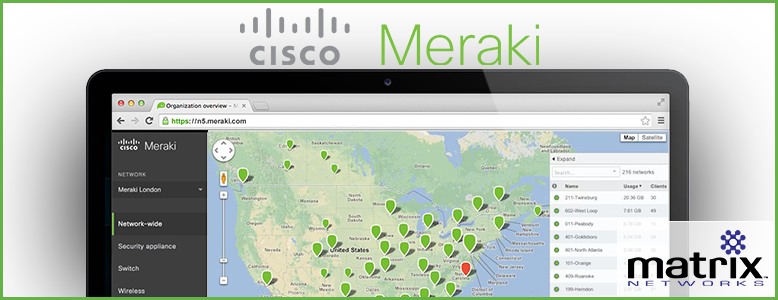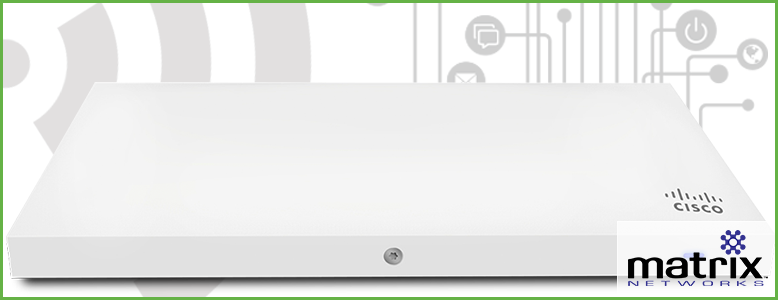
Meraki, a Cisco product, has grown leaps and bounds in the last 5 years, evolving from a niche wireless provider with an incredible set of management tools to a Cisco-owned full network stack product including network switching, next generation firewall, wireless LAN, mobile device management, security cameras, and phone system. The Meraki stack brings the incredible feature set offered by Cisco, but without the dependence on CLI (command line interface). Instead all management and reporting is offered in a single web-based portal. This combination of smart management with the most powerful network toolset in the world gives Meraki a significant edge that all the other major players are chasing. In this article we will expand on why Meraki is winning the battle for network infrastructure.
Ease of Management
Managing the connections between devices and their destinations, and ensuring security while prioritizing traffic has always been challenging. In traditional environments, network administrators must be versed on many different products, using different operating systems, different portals and no true overarching management layer. Meraki takes the complexity away by moving all the various components of a network to one portal, with a single place to apply applications and group or user policies for all your infrastructure. Using virtual stacking (up to 10,000 ports), projects like rolling out VLANS, updating STP or applying QoS policies becomes a couple of clicks and is applied to the selected devices instantly. Enabling Mesh VPN between sites is now a checkbox, eliminating the cumbersome process of setting up IPSEC tunnels between each device. Roll-out of new sites is plug and play. Meraki allows for configuration in transit, giving the IT team the ability to dropship equipment and have local hands plug it in. The equipment is then connected to the network, grabs DHCP, connects to the Meraki cloud, receives configurations, and is ready for use.
Meraki Security
Regardless of the industry, data security is an incredibly important, but often neglected, component of IT. It can be incredibly challenging to choose the right solutions, apply the appropriate policies, design the physical layout, and maintain critical patches while maintaining the performance users expect. For those on the Meraki platform, these challenges are laughable. Managing and applying content filtering across all devices is a dropdown menu, giving you granular control over what is blocked for who and when. Rolling out patches is automated, improving the average of 100 days for patch application to less than 10 hours. Meraki has access to Cisco's robust security tools and is using tools like Snort Sourcefire for IPS/IDS and Cisco's advanced malware protection (AMP) database for real time review of files for malware. Depending on your security needs, additional tools may be needed, but for the majority of businesses Meraki's included security tools will be a vast improvement on the current state of security.
Troubleshooting
Identifying and resolving network issues requires a combination of data collection, analysis, isolation of problems, and a human with an advanced network skillset. Meraki's reporting and troubleshooting tools aim to simplify this process by providing complete visibility into the route paths and physical layout of equipment. The software includes embedded tools to remotely ping, blink LEDs, measure throughput, conduct a traceroute, cycling of ports, WOL, cable testing, remote packet captures, a learned MAC address table, and an easily understood ARP table. Meraki's love of analytics and tools to assist in improving performance is rapidly outpacing the industry with the soon to be released Meraki Insights, designed to give customers visibility into performance issues beyond your own network with visibility into ISP and application specific performance. For wireless customers, the new Meraki Wireless Health provides detailed information on wireless networks, identifying poor performing access points and providing context, so administrators can easily and consistently improve performance. Identifying and resolving network troubles is what keeps us up at night; Meraki lets us sleep easy.
Failover and High Availability
Designing a rock-solid network requires engineers to carefully plan for disaster recovery and failover, while balancing performance for end-users. Meraki has simplified this process dramatically in a variety of ways, allowing even us mere mortals the opportunity to design something spectacular. The MX appliances provide built-in fault tolerance, automating the failover process without the need for a degree in dynamic routing technologies. The system automates the creation of mesh VPN connections between sites, ensuring you are never dependent on a linchpin site for routing. Meraki also supports the use of VRRP with a warm spare; the design allows for a maintaining 100% feature set with limited disruption. Embedded site-to-site SDWAN technology allows Meraki customers to provide optimized Internet performance and automated failover across WAN circuits, private or public. Meraki gear will continue to route even in the event it cannot connect to the Meraki cloud datacenter, an unlikely event considering Meraki maintains multiple datacenters with automated failover in the event of a tertiary location failure. As a network house, we know failure is not an option, deploying Meraki is a surefire way to improve the reliability of your network.
Layer 7 Visibility
I think we can all agree that traffic on a data network is not entirely equal. Some applications are so critical that performance degradation can bring an enterprise to its knees. Yet most of our network tools have limited to no visibility into this critical layer in the OSI model. Meraki gives Layer 7 visibility through the entire network stack, from the Firewall to the client device itself. The solution can then make routing decisions and shape traffic based on the specific application, the importance you place on it, and the real-time nature of the traffic. Layer 7 traffic shaping can also be used to identify and then control bandwidth hogs, allowing you to throttle traffic to social media, streaming services, or any other application that is wreaking havoc. This visibility also provides flexibility for administrators to allow specific traffic like Microsoft O365, SalesForce.com, or RingCentral direct access to the Internet while routing casual web browsing through more beefy security appliances at a headquarter site or a cloud firewall. With Layer 7 awareness, reporting and traffic shaping administrators can truly answer and then eliminate the age-old question, "Why is this so slow?!?!"
Meraki is a product that we are truly excited about here at Matrix Networks. We believe it represents the future of the technology stack, bringing simplicity back without sacrificing the powerful technology that has advanced our businesses. We have invested in our team's knowledge, ensuring they are experts in the entire Meraki stack. We are here to help you design, deploy, and support a future looking network. If you would like to learn more, we offer web demonstrations daily and free 30-day trials with our tech team assisting you with best practices during design, configuration, and deployment. If you would like to dig deeper just let us know how to help!
Visit our Meraki Page to learn more.
Examining the Meraki Fullstack (Part 1)
Addressing interference on a Wireless LAN has been increasing in complexity as more and more radios hit the airwaves. Meraki uses a dedicated 3rd radio in their access points to identify and measure both rogue APs and non-WiFi interference, then uses the data to coordinate channel management to avoid colliding packets.
Continue reading →
Author: Kyle Holmes



.svg%20(1).png?width=55&name=1200px-Logo_of_YouTube_(2015-2017).svg%20(1).png)

